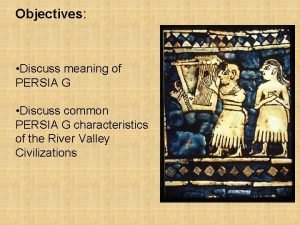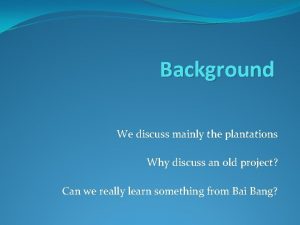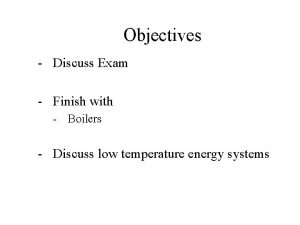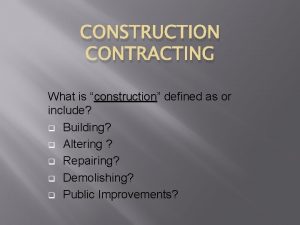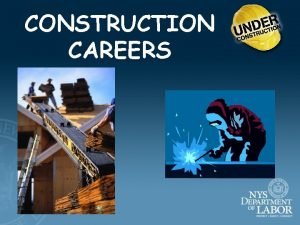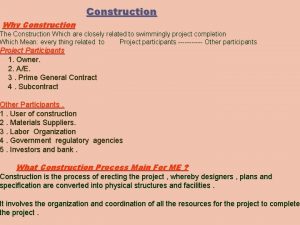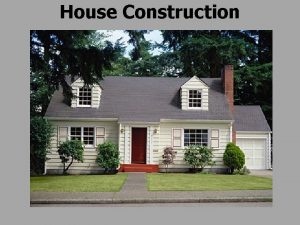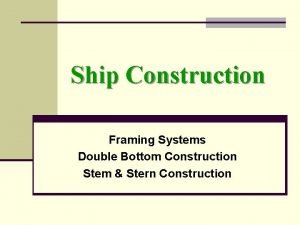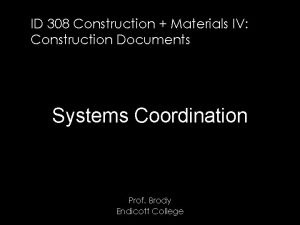The World of Construction Discuss how construction systems



































- Slides: 35

The World of Construction �Discuss how construction systems evolved. �Name some important structures. �Explain the purpose of different construction materials. �Discuss building codes and safety.

The Evolution of Construction

Introduction �When the weather is severe, you can stay safe and dry inside a well-built building. �You might be inside a school, store, restaurant, bus terminal, or hospital. �The buildings we use every day for shelter were assembled by people who work in the construction industry. �Other important construction projects include building roads, bridges, and tunnels. �Other large construction projects include dams, canals, and even space stations.

Types of Construction �Construction systems have existed for as long as people have built structures. �Technology enables construction. �There are three basic types of construction: residential, commercial/industrial, and civil. � 1. Residential construction This type provides places where people live, including apartment buildings and single family homes. � 2. Commercial/industrial construction This type includes office structures, shopping malls, and factories, as well as houses of worship. � 3. Civil construction This type creates large structures for public use. Hospitals and schools are examples, as are roads, bridges, tunnels, and dams. Most civil construction is paid for with tax money collected by the government.

Types of Construction

Buildings �During the American colonial period, many trees grew in the eastern United States. �Log houses were popular because they could be quickly put together. �Log houses, however, were wasteful because so much wood was used. �Their construction also required a great deal of strength to position the heavy logs. �A new type of house construction started to appear in the 1840 s. �Instead of using logs or large wooden beams, these new houses were made of lightweight pieces of wood. This method was called stick construction.

Buildings � The frames went up quickly and provided both safe and strong dwellings. � Almost all modern houses are still built this way. � Even skyscrapers can be built with a type of stick construction that uses steel. � The first skyscraper was the 1885 Home Insurance Building in Chicago. At ten stories high, it was not as tall as some other buildings. However, it was the first to use a metal frame as a basic part of its design. The outside walls were connected to the metal frame. � The walls did not support the building as in log houses. � One of the world’s tallest skyscrapers is Taipei 101 in Taipei, Taiwan. It is 1, 676 feet tall. � Tall and strong modern skyscrapers are made with concrete and steel.

Buildings

Roads �Most ancient roads were little more than dirt paths. �The great road builders of the past were the Romans, who started to build improved roads about 300 b. c. e. �They built 50, 000 miles of roads, more than America’s interstate highway system.

Types of Road Surfaces � Roads can more easily support heavy loads if the roads are covered with a strong and durable material. This covering process is known as surfacing a road. � Early Roads The ancient Romans used flat stones for road surfaces; some early American roads were surfaced with logs or planks placed crosswise. Both types of roads were difficult to maintain. They were also so bumpy that people had to travel on them very slowly. � Mc. Adam Roads Around 1800, George Mc. Adam from Scotland developed a method for making a road surface smooth. He used tar, which comes from crude oil. The tar is heated and spread over a thick layer of crushed rocks on the ground. It is still a common way of surfacing roads, driveways, and parking lots. Americans call this surfacing material “asphalt” or “blacktop. ” The British call it “macadam, ” or they use the brand name “Tarmac. ” � Today’s Roads Today high-speed highways are usually surfaced with concrete because concrete lasts longer than asphalt. Most of America’s approximately 47, 000 miles of interstate highways have concrete surfacing.


Bridges � The Romans of 300 b. c. gave us long-lasting roads, but they also devised strong, well-designed bridges. � They developed the arch—using wedge-shaped stones arranged and locked in a curve. � The arch shape distributed weight sideways as well as downward. � Like their roads, some Roman bridges have lasted for many centuries. � During the late 1700 s, improvements in metal manufacturing greatly reduced the price of iron. That was when people started to make bridges out of iron. � One hundred years later, bridge builders began to use steel, which is a much stronger material. In 1874, the world’s first major all-steel bridge, the Eads Bridge, was built across the Mississippi River at St. Louis, Missouri. � It was named for its designer and chief engineer, James Buchanan Eads. � Modern bridges are still made of steel and supported by concrete.

Bridges

Tunnels �Bridges take people over obstacles, while tunnels take them through or under them. �Tunnels are less noticeable than bridges and can be less inviting. They often make us think of mysterious caves. �The world’s longest tunnel is the Seikan Railway Tunnel in Japan. It is more than 33 miles long, but more than 14 miles are under water.

Other Construction �There are several other types of large construction that are not buildings or houses. �These include �canals, �dams, �and construction of structures used in space.

Canal Construction �Our ancestors used small canals to bring water to their crops. �Canals are human-made waterways. �Ships carrying passengers and products once had to travel a long, dangerous route around the southern tip of South America to get from the Atlantic Ocean to the Pacific Ocean. �One of the largest waterways was opened in 1914, the Panama Canal in Central America. �It was built by American engineers to connect the Atlantic and Pacific Oceans. �Since then trade and travel has increased.

Canal Construction �Panama Canal

Dam Construction �Dams divert the flow of water or cause it to form a pool. Sometimes this can prevent floods. �Dams often improve water supplies and the economy of an area, but that can compete with other needs. �Animal habitats can be changed or destroyed by human made dams; �people can be displaced from their homes; �and areas downstream can become too dry. �Preventing these problems requires a proper balance. �The Chinese government is dealing with these problems as they build the Three Gorges Dam on the Yangtze River in China.

Construction for Space �However, the world’s most unusual and advanced construction project is taking place above the earth— in space. �This project is the International Space Station, being built by the United States and other nations. �It circles, or orbits, around our planet every 90 minutes. �Astronauts take turns living on the space station.

Design Requirements

Understanding Requirements �Like other technology systems, construction systems include inputs, processes, and outputs. �Inputs include the seven resources—people, materials, tools and machines, information, energy, capital, and time. �Processes include designing the structure and putting it together. �Outputs include the structure itself. �Malfunctions of any part of this construction system may affect the way the system works and the quality of the outputs. �For example, if low-quality steel is used, the bridge may collapse.

Understanding Requirements �Engineers and governments place many requirements on construction projects to ensure safety and long life. �For example, the floor in your school classroom must be strong enough to support you and your classmates. �In comparison, the floor in a single family home must support a smaller load or weight. �So, a building code may require your classroom floor to be made of concrete, but the floor in your house could be made of wood. �Although there are no perfect designs, engineers and designers can meet many requirements during the creative design process before building. �Some requirements involve materials, building codes, and safety considerations.

Materials �Centuries ago, before people acquired scientifi c knowledge, they built their homes and other structures from whatever materials were available. �Today scientists and engineers work to develop new and better materials, such as: �Wood �Steel �Concrete �Other materials

Materials - Wood �Trees growing on commercial tree farms produce wood in its natural state. �People cut this wood to make lumber. �Most single-family homes are made from lumber because it is readily available, easy to work with, and economical. �Wood is also a renewable resource. After trees are cut down, new ones can be planted in their place. However, trees take many years to grow, so it is important to “stretch” our current supply of wood. �To do this, crooked trees, sawdust, and other wood wastes are used to create engineered wood materials, such as beams, plywood, and hardboard. �Some engineered wood beams are even stronger than beams made from natural wood.

Materials – Steel �Steel is a mixture of iron and small amounts of carbon. It is used primarily to support large structures. �Skyscrapers, for example, are built with a steel framework. Then floors and interior walls are added. The outside walls are hung on the metal frame. �The walls do not help support the building. These exterior walls are called curtain walls. �They can be made of many different materials, including glass. �Commercial buildings are sometimes made with steel supports and painted steel walls. �These buildings might be airport terminals, grocery stores, and factories. �Many suspension bridges are made of steel.

Materials – Steel

Materials – Concrete � Made of a mixture of dry cement, sand, stones, and water, concrete is the most � adaptable construction material. � Builders use it for large buildings, highways, dams, bridges, and foundations of houses. � Nearly every structure contains some concrete. Some people call concrete “cement, ” but cement is just one ingredient in a concrete mixture. � It is the binder that holds everything together. � Concrete begins as a mixture that looks like ordinary mud. � It is poured into forms or molds that hold it in place while it hardens. These forms give the concrete its final shape. � Depending on the shape, it can be used for many purposes. � Steel reinforcing rods or other steel shapes can be placed in the wet concrete to help strengthen it.

Materials – Concrete

Materials – Other Materials �Many construction methods use materials besides wood, steel, or concrete for specific applications. �For example, asphalt is an important surfacing material, made of crude oil and other substances, used for road construction and repair, driveways, and walkways.

Materials – Other Materials �Composite materials are used for some bridges. �A composite is a combination of two or more materials, such as fiberglass and carbon. �Composite materials are much lighter than concrete and are weather-resistant, unlike steel. �Composites are used for products such as bathtubs and roofing materials.

Materials – Other Materials �Materials for Subsystems �Builders also use other materials in construction, such as � masonry (bricks and stone), � window glass, � vinyl exterior wall coverings, � fiberglass insulation, � copper wire, � and plastic water pipes. �These materials are usually part of a structure’s subsystems.

Regional Requirements � Many regions in the United States have different types of terrain and weather. � Structures designed for one region might not be suitable for another region. � For example, flatter roofs commonly appear on houses, where there is little snow. � However, people in the north must be concerned about the weight of snow on their roofs in the winter. � If flat roofs were used, the snow would not slide off easily, and the roofs might collapse. � The people in California and some other states must build structures to withstand earthquakes. � People in some central states experience tornadoes. � Other regions must be ready for floods and rising water, and/or landslides.

Building Codes � Local governments establish rules regulating the types of structures that can be constructed in their areas. � Rules are part of the information inputs used by construction systems. They are called building codes. � Construction specialists agree that there must be certain standards for each structure. � Commercial buildings must have enough exits in case of an emergency. � Houses must have safe water supplies. � Bridges and tunnels must support heavy loads. � These are just a few of the many objectives of building codes. � Building codes can vary by state, county, or city. They are modified as new materials and methods of construction are developed. � Before construction begins, builders contact a local inspection office at city hall or the county courthouse to apply for a permit. The builders must follow the regulations in the building code books.

Building Codes - cond �For example, a builder might not be allowed to construct a tall building in a town’s historic district because people want to preserve the historic appearance of the area. �In another case, the building codes might permit building a house near a lake, river, or seashore if the house is on strong poles to keep it above water. �Building codes are designed to protect people’s safety and the environment. They cover electricity, plumbing, energy use, and most other aspects of construction. �That is why there is a lot of paperwork associated with building a new structure.

Safety � Buildings, bridges, and other structures are designed to support much more weight than would be placed on them. Engineers call this conservative design. � Any major structural failure usually appears on the national news because it is a rare event. � Nature can produce disastrous volcanic eruptions, tornadoes, tsunamis, and hurricanes, such as Hurricane Katrina in 2005, that result in severe damage. � Things happen that nobody can predict. So, engineers design escape routes and safety devices. � All tall buildings have elevators, but they also have stairways in case electricity is cut off. � Sprinklers put out small fires and keep them from spreading. � Entrance doors and emergency exits in public buildings open outward so people can leave quickly. � When accidents or other problems occur, engineers troubleshoot to prevent problems from happening again. � New innovative technologies have sometimes resulted.
 Amateurs talk tactics professionals talk logistics
Amateurs talk tactics professionals talk logistics Hát kết hợp bộ gõ cơ thể
Hát kết hợp bộ gõ cơ thể Ng-html
Ng-html Bổ thể
Bổ thể Tỉ lệ cơ thể trẻ em
Tỉ lệ cơ thể trẻ em Chó sói
Chó sói Tư thế worms-breton
Tư thế worms-breton Hát lên người ơi alleluia
Hát lên người ơi alleluia Các môn thể thao bắt đầu bằng từ đua
Các môn thể thao bắt đầu bằng từ đua Thế nào là hệ số cao nhất
Thế nào là hệ số cao nhất Các châu lục và đại dương trên thế giới
Các châu lục và đại dương trên thế giới Công của trọng lực
Công của trọng lực Trời xanh đây là của chúng ta thể thơ
Trời xanh đây là của chúng ta thể thơ Mật thư anh em như thể tay chân
Mật thư anh em như thể tay chân Làm thế nào để 102-1=99
Làm thế nào để 102-1=99 độ dài liên kết
độ dài liên kết Các châu lục và đại dương trên thế giới
Các châu lục và đại dương trên thế giới Thể thơ truyền thống
Thể thơ truyền thống Quá trình desamine hóa có thể tạo ra
Quá trình desamine hóa có thể tạo ra Một số thể thơ truyền thống
Một số thể thơ truyền thống Cái miệng nó xinh thế chỉ nói điều hay thôi
Cái miệng nó xinh thế chỉ nói điều hay thôi Vẽ hình chiếu vuông góc của vật thể sau
Vẽ hình chiếu vuông góc của vật thể sau Nguyên nhân của sự mỏi cơ sinh 8
Nguyên nhân của sự mỏi cơ sinh 8 đặc điểm cơ thể của người tối cổ
đặc điểm cơ thể của người tối cổ V cc
V cc Vẽ hình chiếu đứng bằng cạnh của vật thể
Vẽ hình chiếu đứng bằng cạnh của vật thể Tia chieu sa te
Tia chieu sa te Thẻ vin
Thẻ vin đại từ thay thế
đại từ thay thế điện thế nghỉ
điện thế nghỉ Tư thế ngồi viết
Tư thế ngồi viết Diễn thế sinh thái là
Diễn thế sinh thái là Dạng đột biến một nhiễm là
Dạng đột biến một nhiễm là Thế nào là số nguyên tố
Thế nào là số nguyên tố Tư thế ngồi viết
Tư thế ngồi viết Lời thề hippocrates
Lời thề hippocrates






































